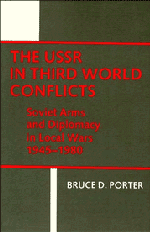Book contents
- Frontmatter
- Contents
- Preface
- 1 Introduction
- 2 The USSR in local conflicts: a historical overview
- 3 Soviet power projection: advances in postwar military capabilities
- 4 The case studies: a framework for analysis
- 5 The Yemeni civil war
- 6 The Nigerian civil war
- 7 The Yom Kippur war
- 8 The Angolan civil war
- 9 The Ogaden war
- 10 Conclusions
- Index
4 - The case studies: a framework for analysis
Published online by Cambridge University Press: 05 August 2011
- Frontmatter
- Contents
- Preface
- 1 Introduction
- 2 The USSR in local conflicts: a historical overview
- 3 Soviet power projection: advances in postwar military capabilities
- 4 The case studies: a framework for analysis
- 5 The Yemeni civil war
- 6 The Nigerian civil war
- 7 The Yom Kippur war
- 8 The Angolan civil war
- 9 The Ogaden war
- 10 Conclusions
- Index
Summary
Investigators, however, who have paid careful attention to more than one country or area… have soon discovered the intellectual power that is inherent in such comparisons.
Karl DeutschThe preceding three chapters have presented a considerable amount of general material on the USSR's involvement in Third World conflicts, including historical background, Soviet ideological perspectives, and development of military capabilities that made such involvement possible. This establishes the necessary foundation for exploring more closely the USSR's policy and behavior in specific local wars. Five conflicts in which the Soviet Union was involved have been chosen as case studies for this purpose. This chapter will elaborate the criteria of their selection and outline the framework to be used in analyzing them.
The criteria of selection
In singling out conflicts for case study, only the postwar era was considered – most examples of Soviet involvement in local conflicts took place after 1945 anyway, and it is the period most relevant to contemporary Soviet policy and current American concerns. Moscow was involved militarily in at least 20 conflicts in the Third World between 1945 and 1980 (see Table 2.1). These 20 conflicts were narrowed down to five by applying the following criteria:
The contenders were non-Communist. This restriction eliminates the Chinese civil war, the Korean war, the Laotian civil war, the war in Vietnam, Hanoi's invasion of Cambodia, the Sino-Vietnamese border war of 1979, and the civil war in Afghanistan.
- Type
- Chapter
- Information
- The USSR in Third World ConflictsSoviet Arms and Diplomacy in Local Wars 1945–1980, pp. 60 - 65Publisher: Cambridge University PressPrint publication year: 1984

